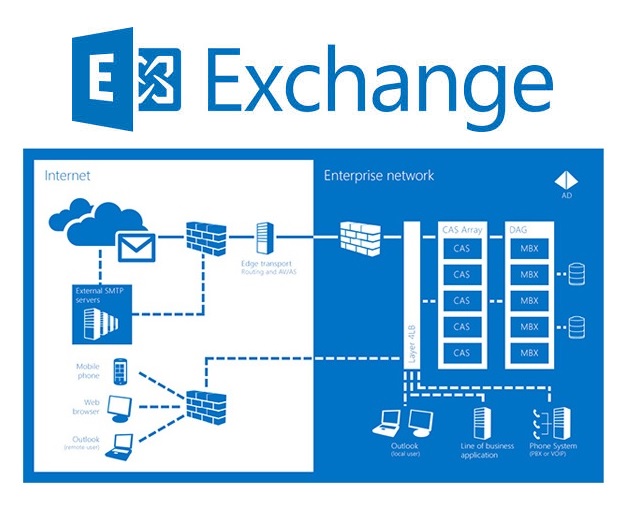Remember a while back when you unboxed that shiny new server you ordered for Microsoft Exchange? You were pleased with the dual 64-bit processors – and it had gobs of memory. You installed Exchange and migrated over your existing storage array. Things were up and running in no time and everyone was happier with the snappy response.
Finally, you could get on to the many other IT challenges your growing company was pitching your way. There’s never a shortage of projects, setting up new laptops and of course those “pop-up emergencies.” As time went on and the number of employees grew rapidly, your Exchange email load grew exponentially until one day, everything seemed like it was moving in slow motion…
An April 2014 study by The Radicati Group reports that Microsoft Exchange holds 64% of the on-premises messaging and collaboration market and that it’s expected to grow to 76%. To say that Exchange is ubiquitous is an understatement. A Google search for “Microsoft Exchange Server performance problems” brings over 2.4 million hits – so you can see that you’re not alone in your quest for a quick and inexpensive fix. There are literally hundreds of software analyzers, diagnostics and tools related to Exchange performance. But most cost money and all take time to come up to speed on and make sense of their analytics.
Switch from SATA to SAS HDDs
If your mailbox storage needs are growing but performance is lagging only slightly, you may want to consider just swapping out your smaller 7,200 RPM 6Gb/s SATA drives for some 12Gb/s SAS 6TB enterprise-capacity drives. This is especially easy to justify if you can re-purpose the SATA drives elsewhere in your IT infrastructure. To take advantage of the 2x larger SAS pipeline, you’ll want to be sure you have a 12Gb/s capable SAS HBA with the latest drivers in your server as well (many RAID adaptors support both SATA and SAS). If you’re using a 2Ux12 storage array, this option will run you around $5,800 for twelve 6TB capacity drives.
Move your log files to a 15,000 RPM SAS HDD
 For those times where you have plenty of mailbox space but high volumes of both users and email traffic, an I/O bottleneck might be the cause for your slowdown. I/O bottlenecks typically occur when the number of read/write requests from the server to the disks exceeds the response-time capability of the drives. This causes the server to sit there and twiddle its thumbs while the drive reads (or writes) the data. A 7,200 RPM HDD has a latency (the combined time it takes for the head to seek to the desired location, for the data to rotate around under the head and the data to be returned to the server) of 4.16 milliseconds (ms).
For those times where you have plenty of mailbox space but high volumes of both users and email traffic, an I/O bottleneck might be the cause for your slowdown. I/O bottlenecks typically occur when the number of read/write requests from the server to the disks exceeds the response-time capability of the drives. This causes the server to sit there and twiddle its thumbs while the drive reads (or writes) the data. A 7,200 RPM HDD has a latency (the combined time it takes for the head to seek to the desired location, for the data to rotate around under the head and the data to be returned to the server) of 4.16 milliseconds (ms).
Well a 15,000 RPM drive returns data twice as fast as a 7,200 RPM drive – with a latency of only 2 ms. Now if you integrate some non-volatile flash memory onto the HDD interface card, you can cut the latency even further for certain operations and get up to 3 times more IOPS. Seagate has done just that with a new feature called TurboBoost™ which provides the speed of flash at a lower cost than SSD. Adding a couple of 15,000 RPM enterprise performance drives will only set you back about $1,000 (you’ll want at least 2 drives for RAID 1 redundancy protection).
When all else fails, try SAS SSD for your log files
Sometimes there’s no other way than “going for broke” to get the performance level you need. I’m sure you’ve heard the hype about all-flash arrays. It’s not only on all the IT mag sites, but I also hear some SSD providers and high-end storage system companies touting it heavily. A 2Ux24 bay array of these will cost $64,000+ (just for the drives). Halve that to a 12-bay system and that’s still around $32,000. On the other hand, if it’s unlikely your boss will approve an expense at that level, there are some other down-to-Earth options…
Sometimes adding just a few strategically placed SSDs may give just the boost you want. For extremely high-transaction systems with small “hot files” there’s nothing like SSD to make things hum along. I first learned this back in the dot-com run up when I was at an SSD start-up. In one particular case with a telecom provider that sold text-messaging server systems, adding just one SSD enabled the system to process 10 times the number of text messages per second. If you compare the cost of a single SSD to what 10 times the servers, storage, rack space and electricity would have cost, you can see why they were a very happy customer and sold tons of those systems worldwide.
Now back to your Exchange performance issue. If you have many hundreds to thousands of users, SAS SSD may be the solution for you. Just like with the 15,000-RPM drives, you probably only need a couple of SSD to really make the difference (because modern SDDs are so reliable I would say you likely only need one – but for protection against catastrophic failure, while extremely rare, I still recommend two).
You will recall what I mentioned about latency on the 7,200- and 15,000-RPM drives. Of course SSD has no seek and rotational latency so it is way faster – like up to 1,000 times faster (SSD latency is measured in microseconds rather than milliseconds for HDDs). Since SSD responds at the speed of the flash memory and interface electronics, it can also move about 3x more data per second, or around 750 MB/s versus 230 MB/s for a rotating HDD. So what do you think, would the number of users you’re supporting on Exchange justify the $5,300 cost of two 800GB SSDs? Sure SATA SSD cost a little less, but then again the interface is only 6 Gb/s where SAS is 12 Gb/s – and that sort of defeats the purpose!
Exchange performance tuning doesn’t have to be difficult
As I’ve discussed here briefly today, you have problems to solve and not a lot of time to slice and dice the various causes. Given the ample processing power of today’s 64-bit server architectures and the availability of relatively inexpensive DRAM – storage devices tend to be the slowest part of the system. I/O bottlenecks can sneak up on you as your organization grows and the number of emails explodes exponentially. Many mid-range Microsoft Exchange Server installations can benefit from reassessing the balance of the installed storage devices. If you need a little help prioritizing your storage requirements, or comparing drives by system capacity, performance, density and efficiency, you can input a few parameters into the Enterprise Storage Optimizer tool here to get some guidance and a customized drive report.
—
Mark Hall is a storage industry veteran who has held senior product management and product marketing roles at the likes of storage vendor Hitachi Data Systems, solid-state startup Solid Data Systems, array manufacturer Xyratex and drive manufacturer Hitachi Global Storage Technologies. Mark holds a BS in Computer Science and an MBA and is senior marketing manager for Cloud and Kinetic Drives for Seagate Technology. In his off hours he enjoys interests in diet and nutrition, walking, bike riding, all of the newest gadgets and spending time with friends and family.








